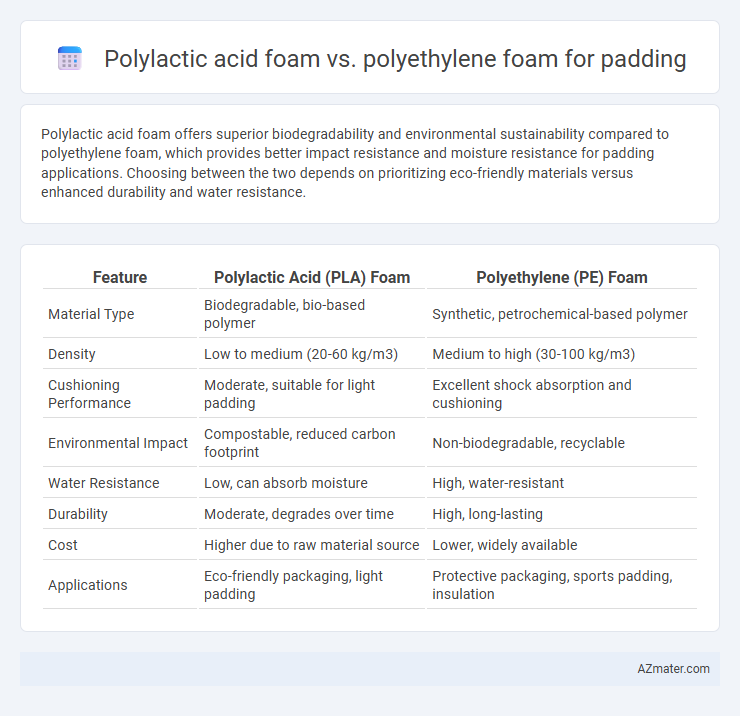Polylactic acid foam offers superior biodegradability and environmental sustainability compared to polyethylene foam, which provides better impact resistance and moisture resistance for padding applications. Choosing between the two depends on prioritizing eco-friendly materials versus enhanced durability and water resistance.
Table of Comparison
| Feature | Polylactic Acid (PLA) Foam | Polyethylene (PE) Foam |
|---|---|---|
| Material Type | Biodegradable, bio-based polymer | Synthetic, petrochemical-based polymer |
| Density | Low to medium (20-60 kg/m3) | Medium to high (30-100 kg/m3) |
| Cushioning Performance | Moderate, suitable for light padding | Excellent shock absorption and cushioning |
| Environmental Impact | Compostable, reduced carbon footprint | Non-biodegradable, recyclable |
| Water Resistance | Low, can absorb moisture | High, water-resistant |
| Durability | Moderate, degrades over time | High, long-lasting |
| Cost | Higher due to raw material source | Lower, widely available |
| Applications | Eco-friendly packaging, light padding | Protective packaging, sports padding, insulation |
Introduction to Padding Materials
Polylactic acid (PLA) foam and polyethylene (PE) foam are widely used padding materials offering distinct environmental and performance characteristics. PLA foam, derived from renewable resources like corn starch, provides biodegradability and compostability, making it ideal for eco-friendly applications. PE foam, a petroleum-based polymer, offers superior durability, cushioning, and moisture resistance, commonly utilized in packaging and sports equipment for enhanced protection.
Overview of Polylactic Acid (PLA) Foam
Polylactic Acid (PLA) foam, derived from renewable resources like cornstarch, offers a sustainable alternative to traditional polyethylene foam for padding applications due to its biodegradability and compostability. PLA foam provides effective cushioning and impact absorption, making it suitable for protective packaging and insulation, while exhibiting lower environmental impact compared to polyethylene foam, which is petroleum-based and non-biodegradable. Its renewable origin and eco-friendly disposal options position PLA foam as an innovative choice in sustainable padding materials.
Overview of Polyethylene (PE) Foam
Polyethylene (PE) foam is a lightweight, closed-cell material known for its excellent cushioning, shock absorption, and moisture resistance, making it ideal for padding applications. Unlike polylactic acid foam, PE foam offers superior durability, chemical resistance, and long-term performance in diverse environmental conditions. Its versatility and cost-effectiveness have established PE foam as a preferred choice for protective packaging, sports equipment, and automotive padding.
Environmental Impact: PLA vs. PE Foam
Polylactic acid (PLA) foam offers a significant environmental advantage over polyethylene (PE) foam due to its biodegradable properties and production from renewable resources like cornstarch or sugarcane. PLA foam decomposes under industrial composting conditions within months, reducing landfill accumulation and microplastic pollution commonly associated with PE foam, which is derived from non-renewable fossil fuels and persists in the environment for centuries. Lifecycle assessments show PLA foam generates lower carbon emissions and less energy consumption during manufacturing compared to conventional PE foam, making it a more sustainable option for eco-friendly padding applications.
Cushioning Performance and Shock Absorption
Polylactic acid (PLA) foam offers superior cushioning performance due to its biodegradable, closed-cell structure that provides excellent energy absorption and resilience. In comparison, polyethylene (PE) foam exhibits high shock absorption capabilities with its lightweight, flexible, and durable closed-cell composition, often used in protective packaging and sports equipment. PLA foam's eco-friendly nature makes it a preferable choice for sustainable cushioning, while PE foam remains favored for long-lasting, repeated shock attenuation in industrial applications.
Comfort and Breathability Factors
Polylactic acid (PLA) foam offers superior breathability and moisture-wicking properties compared to polyethylene (PE) foam, enhancing comfort by reducing heat buildup and sweat accumulation during extended use. PLA foam's biodegradable nature also contributes to a softer, more adaptive cushioning effect that conforms better to body contours, improving overall padding comfort. In contrast, PE foam provides excellent shock absorption but tends to trap heat and moisture, which can lead to discomfort in high-performance or prolonged applications.
Durability and Longevity Comparison
Polylactic acid (PLA) foam offers eco-friendly biodegradability but generally has lower durability and shorter lifespan compared to polyethylene (PE) foam, which exhibits excellent resistance to abrasion, moisture, and chemicals. Polyethylene foam maintains its cushioning properties and structural integrity over extended periods, making it highly suitable for long-term padding applications. In scenarios demanding persistent impact absorption and wear resistance, PE foam typically outperforms PLA foam in terms of longevity and durability.
Cost-Effectiveness Analysis
Polylactic acid (PLA) foam offers a biodegradable alternative to polyethylene (PE) foam, with slightly higher material costs but improved environmental benefits. PE foam remains more cost-effective due to its widespread availability, lower production expenses, and durability in padding applications. When weighing cost-effectiveness, PE foam typically provides better value for high-volume, long-lasting cushioning needs, while PLA foam appeals to eco-conscious markets seeking sustainable solutions despite higher pricing.
Applications in Padding Industries
Polylactic acid (PLA) foam offers biodegradable and eco-friendly padding solutions widely used in consumer electronics, medical packaging, and food service industries due to its compostable nature and good cushioning properties. Polyethylene (PE) foam, known for its excellent impact resistance, thermal insulation, and durability, is commonly utilized in automotive, sports equipment, and industrial packaging applications. The choice between PLA and PE foam depends on environmental considerations and specific performance requirements such as flexibility, moisture resistance, and reusability in padding industries.
Future Trends in Foam Padding Materials
Polylactic acid (PLA) foam is rapidly gaining momentum in foam padding applications due to its biodegradability and renewable sourcing, aligning with global sustainability goals. Polyethylene (PE) foam remains widely used for its durability and excellent shock absorption but faces challenges due to environmental concerns and recycling difficulties. Future trends lean towards hybrid foams combining PLA's eco-friendliness with PE's mechanical robustness, alongside advancements in bio-based additives and nanotechnology to enhance foam performance and lifecycle.

Infographic: Polylactic acid foam vs Polyethylene foam for Padding
 azmater.com
azmater.com